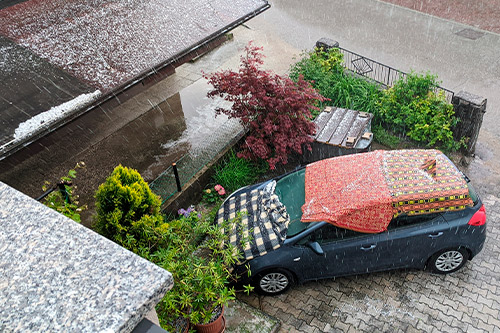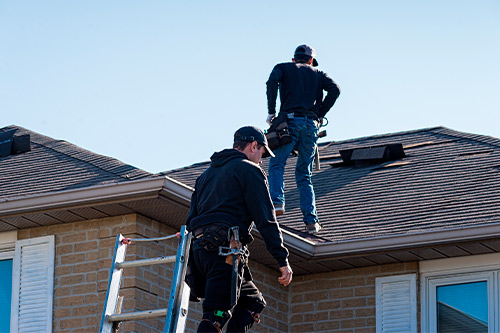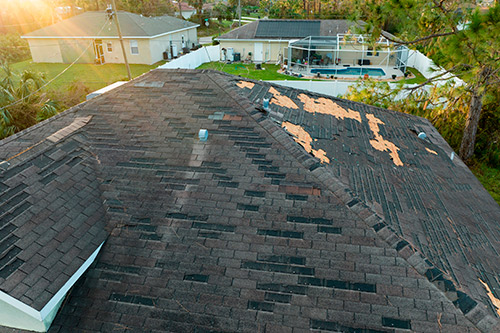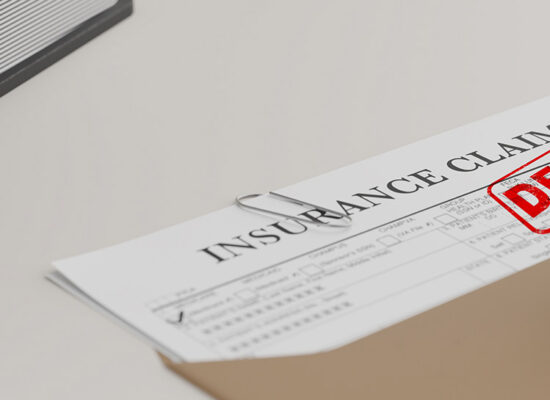Understanding and Documenting Hail Damage in Edinburg: A Guide for Homeowners
Hailstorms in Edinburg and the Rio Grande Valley can arrive suddenly and cause serious property damage. Whether it’s cracked shingles or broken windows, it’s crucial to recognize and properly document the damage if you plan to file an insurance claim.
In this guide, we’ll walk you through:
- The most common types of hail damage
- What kind of evidence is essential for your claim
- How to organize and submit your documentation
- Tips for getting your claim approved
Common Hail Damage in Edinburg

The aftermath extends beyond physical damage. Homeowners face significant financial strain from repair costs that can easily reach tens of thousands of dollars. This financial burden is compounded by the emotional stress of navigating complex insurance claims while trying to restore safety and normalcy to your home.
Common Issues to Look For:
- Roof Shingles: Cracked, punctured, or missing granules (reduces lifespan and water resistance)
- Gutters and Downspouts: Dented or detached
- Siding and Windows: Chipped paint, holes, shattered glass
- Outdoor Units: Damaged A/C compressors, vents, and solar panels
- Interior: Leaks or water stains from compromised roofing [PL Hail Damage Insurance North Texas]
Hidden damage: One of the most common issues is damage to the underlying insulation and roofing structure. The weakened roofing material allows moisture to seep through, often unnoticed at first. This slow intrusion can lead to:
- Insulation degradation: Wet insulation becomes less effective, increasing energy bills and reducing indoor comfort.
- Mold and mildew growth: Moisture trapped inside walls or attics creates the perfect environment for toxic mold, posing health risks.
- Structural rot: Persistent leaks can damage wood framing, leading to rot and weakening of the home’s structure.
- Electrical hazards: Water can reach electrical wiring, increasing the risk of short circuits or fires.
Because these issues may not become apparent until weeks or months later, it’s vital to have a professional inspection after any major hailstorm, even if your roof looks fine from the ground. Insurance companies are more likely to deny coverage for damage discovered long after a storm, so identifying these problems early and documenting them thoroughly is key to a successful claim.
Evidence for a Hail Damage Claim

Key Types of Evidence
A wide range of evidence that clearly proves both the extent of damage and the timing of the storm is required to support a successful hail damage insurance claim in Edinburg. Below is a quick-reference table outlining the key types of documentation that you should collect and organize:
| Category | Description |
| Visual Documentation | Photos/videos of damage from various angles, including close-ups and wide shots |
| Preserve Evidence | Preserve physical evidence such as fallen hailstones, although photos of the size, compared against something else, also serves as good evidence |
| Storm Verification | Timestamped weather reports, news clippings, photos of actual hailstones |
| Maintenance Records | Pre-storm upkeep logs and receipts for any recent home improvements |
| Repair Records | Estimates, invoices, or temporary repair bills post-storm |
| Communication Log | Notes, emails, and texts exchanged with your insurer Keep dates, times, communication content, and any correspondence Note representative’s name and position Promises, deadlines, and next steps discussed Always follow telephone conversations with emails |
| Professional Reports | Independent evaluations by contractors, engineers, or public adjusters bring in trained eyes to compile a detailed report |
Use smartphone features like geo-tagging and timestamps to add credibility.
How to Gather and Organize Your Hail Damage Evidence
A systematic approach not only simplifies the claims process, it strengthens your case.
- Step-by-Step Damage Documentation
- Stay Safe First – Ensure the area is secure before starting.
- Start Outside – Photograph roofing, siding, gutters, and A/C units.
- Move Indoors – Document ceiling stains, leaks, broken windows, and flooring.
- Take Videos – Narrate walkthroughs, explaining damage and when it occurred.
- Save Physical Evidence – Freeze a few hailstones and photograph next to a coin/ruler.
Tips for Organizing Evidence
- Create Digital Folders by category: photos, videos, estimates, communications, weather reports.
- Use Clear File Names, e.g., 2025-05-14_Roof_SouthSide.jpg
- Back Up Files to a cloud service or external hard drive.
- Keep Paper Receipts in waterproof folders.
- Keep Detailed Reports from independent contractors
- Make a Damage Inventory Spreadsheet, including:
- Location of damage
- Item description
- Approximate age
- Estimated repair cost
Tips for a Successful Hail Damage Claim in Edinburg

✅ Do:
Report the damage promptly (usually within 30–60 days)
Get independent contractor assessments
Hire a public adjuster for complex or high-value claims
Keep all documentation in one place
Seek help from a property damage attorney if your claim is delayed or denied
❌ Don’t:
Accept the first offer without review
Attempt repairs without proper documentation
Ignore signs of hidden damage (water stains, sagging ceilings)
If your claim is denied, request a written explanation and file an appeal with additional documentation. Many initially rejected claims are later approved with proper evidence.
Get Help Navigating a Denied or Underpaid Claim

Don’t let your insurance company dictate your recovery. Contact Palker Law Firm today for a free consultation and get the compensation you deserve.
FAQs
1. How can I tell if my roof has hail damage?
Look for dented shingles, granule loss, cracks, or bruised spots. You might also notice damaged flashing, gutters, or skylights. A professional inspection is recommended, as some damage is not visible from the ground.
2. Should I file a claim even if the damage seems minor?
Yes. Even small dents can compromise your roof’s lifespan and lead to future leaks or structural problems. Filing a claim ensures your insurance provider is aware and allows you to get repairs before the damage worsens.
3. How long do I have to file a hail damage claim in Texas?
Most Texas homeowners’ insurance policies require claims to be filed within 30 to 60 days of the storm. However, the sooner you file, the better your chances of success.
4. What if I don’t have photos or documentation from before the storm?
While it helps to have pre-storm photos, you can still file a claim using storm reports, neighbor statements, and a professional assessment. Going forward, it’s a good idea to document your home’s condition regularly.
5. Will my insurance premium increase if I file a hail damage claim?
Hail damage is typically considered an “act of God”, so most insurers won’t raise your premium for a weather-related claim. However, your overall risk profile may be affected in the long term.
6. Can I make temporary repairs before the insurance adjuster arrives?
Yes, and in many cases, you should, especially to prevent further damage. Just be sure to take detailed photos before making repairs and keep all receipts for reimbursement.
7. What should I do if my claim is denied or underpaid?
Request a written explanation from the insurer, then consider a formal appeal with additional documentation. You may also benefit from working with a public adjuster or a property damage attorney to strengthen your case.
8. Do I need to get multiple estimates before repairs?
Some insurance companies require more than one estimate, but one detailed, professional quote is often sufficient, especially if it includes photos and itemized costs. Check with your insurer for specific requirements.
9. Can I choose my own contractor for repairs?
Yes. You’re not obligated to use the insurance company’s preferred vendor. Choosing a local, reputable contractor ensures quality work and someone you can hold accountable if issues arise.
10. Should I hire a lawyer to help with my hail damage claim?
If your claim is delayed, denied, or underpaid, hiring an attorney, especially one familiar with Texas hail claims, can greatly improve your chances of receiving a fair settlement. Texas law often requires insurers to cover legal fees if the claim is justified.






